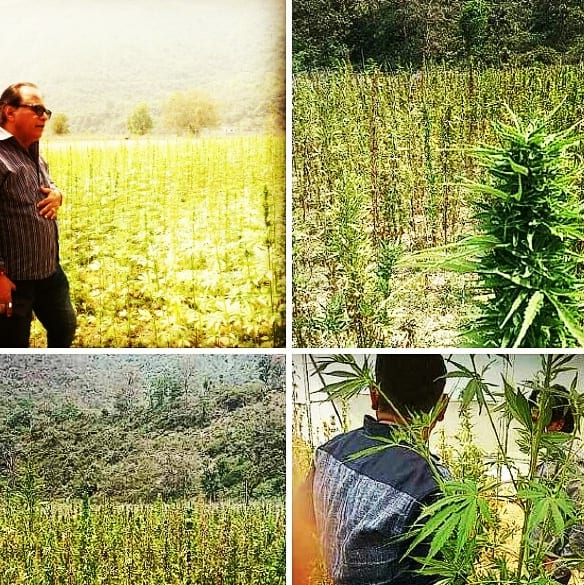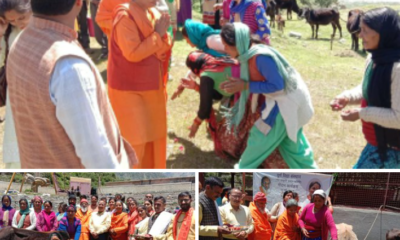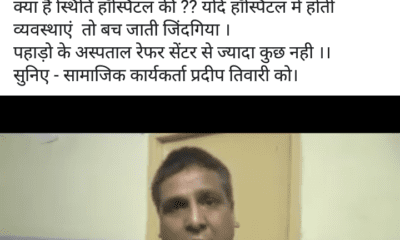India
Hemp cultivation in progress near Bilkhet, Satpuli, Garhwal, Uttarakhand

While the himalayan state of Uttarakhand is confronted with the main problem of mass exodus of villagers to the cities and metropolises for want of job avenues, the government of the day led by chief minister Trivendra Singh Rawat has approved the policy to cultivate hemp farming in the state to encourage local employment and subsequent use of barren fields for hemp production to enable the field/ farm’ owners acknowledge a reasonable rent from the Industrial hemp companies for the sustenance of their respective families who’ve given up agricultural farming since a decade or two ago.
In Uttarakhand about 35 lakh people have migrated to the plains during the last 18 years in the absence of health, quality education and employment related facilities /avenues.
As a result majority of the farm land and vast tracts of agricultural fields are lying vacant in villages on the hills as well as near the town areas or plains.
This phenomena is the biggest tragedy of the Uttarakhand hills where non availability of man power n resources has resulted in agricultural land lying vacant n barren with the dominance of the wild animals like leopards, wild bears, pigs n monkeys creating havoc around.
In order to engage these unused agricultural lands n provide employment to the local youths, though in limited numbers, the Uttarakhand government led by chief minister TS Rawat has formally approved the policy for industrial hemp cultivation in Uttarakhand after Harish Rawat’s previous Congress government introduced it in 2016 but could not implement due to tremendous opposition from various sections of the society n media hype.
The current government running under the deficit financing, believes in drawing maximum revenue from liquor sale in the state in order to bridge the fiscal deficit as well as increase economic health of the state.
This year it recovered about 23 hundred crores after liquor sale. The government believes that through the cultivation of industrial hemp it would slowly n gradually earn a handsome revenue in the coming years.
This industrial hemp cultivation is currently being done at Bilkhet near Satpuli Garhwal n in some areas of Haridwar, Uttarakhand as well.
According to the manager of the pilot project of Indian Industrial Hemp Association at Bilkhet, Ashish Rawat, this hemp is negligibly harmful n intoxicated than the wild bhang plants which usually crop up in several areas of Uttarakhand n misused by the unscruplous elements n misguided youths.
The high quality seed of the hemp plant imported from abroad costs at ten dollars a seed. This is a highly expensive affair.
Therefore the company is doing R&D n producing its own seeds at Bilkhet, Satpuli which are quite cheaper and of the same imported quality.
The huge agricultural fields are taken in lease from the local farmers on Rs. 4500 rent for per acre land usage on annual basis.
Today this hemp farming is being carried out in in 1400 Nalies area. One Naalee consists of 200 square metre area.
The plants of this medicinal hemp takes three months to grow after which they are sent to factories for taking out fine n strong fibres for preparing high quality cloth as well as 24000 products including medicinies, especially anti cancer, anti HIV n heart ailment curing drugs.
It’s also used to manufacture bio fuel, varnishes, paints, cosmetics etc.
The cloth prepared by its fibre is very strong n of fine quality. The hemp farming on wide scale also leads to deforrestation n therefore environmental protection, as one acre of Hemp cultivated can also produce paper equivalent to the paper produced by trees cut on four acres of land.
The best climate to produce these marajuana plants is the winter seasons starting from January onwards.
It may be recalled that countries like China, New Zealand, Australia n European nations are doing hemp farming on large scale giving massive employment as well as earning substantial profits by selling the product to medicinal and cloth industries n even exporting them abroad.
Clearing the misconception about the bad affect or the negative aspect of the hemp cultivation IIHA n its subsequent misuse, the manager of this pilot project Ashish Rawat said that this industrial hemp cultivation is of the lowest quality as far as its intoxication level is concerned as compared to the usual wild cannabis plants and is highly beneficial for the medicinal industry especially for the manufacture of anti cancer, anti HIV n heart ailments curing live saving drugs n thousands of other medicines compounded with its use in manufacturing the hemp crete for construction activities n also for producing fine fabrics.
It may be recalled that the Indian Industrial Hemp Association ( IIHA) is a non profit organisation registered against the trust act 1882, the copy right act 1999 with a motive to promote India Industrial hemp n I hemp products globally. IIHA is the only association in league to advocate industrial hemp cultivation ; first to cultivate hemp legally after procuring relevant licences, post legalisation in Uttarakhand.
According to the Advisor to the Industrial Hemp Association Bir Singh Negi based in Dehradun, Industrial Hemp which was originally allowed by Harish Rawát, the former CM of Uttarakhand on 16 th December 2016 but due to short time it could not take off .
This is variety of canabis having less than 0.3 percent THC (tetra hydro cannabinol ). Negi says that the present cm is trying to promote it as it can change the economy of hills since the crop is least affected by wild animals n require comparatively less water n not affected by disease n pest. State has allowed it only for fiber n seeds n not for medicinal use .
The Indian industrial hemp association is basically focusing on seed production for variety having less than 0.3 percent THC which is a main stumbling block to promote this crop.
Hemp farming in progress in Bilkhet near Satpuli. The ancestral village of the CM Rawat is Khaira Chamasu under patti Maundarsyun about 10 kilometres away from Bilkhet. ( Above)








































